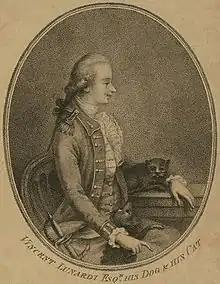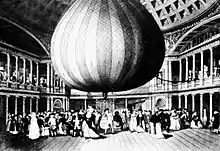Vincenzo Lunardi | |
|---|---|
 Vincenzo Lunardi | |
| Born | 11 January 1759 |
| Died | 1 August 1806 |
Vincenzo Lunardi (11 January 1754 in Lucca – 1 August 1806 in Lisbon) was a pioneering Italian aeronaut, born in Lucca.
Ascents in England
Vincenzo Lunardi's family were of minor Tuscan nobility from Lucca, and his father had married late in life. Vincenzo was one of three children. He travelled in France in his early years before being called home, where he was put into the diplomatic service. Vincenzo Lunardi came to England as Secretary to Prince Caramanico, the Neapolitan Ambassador.
15 September 1784
There was a flying craze in France and Scotland with James Tytler, Scotland's first aeronaut and the first Briton to fly, but even so and after a year since the invention of the balloon, the English were still skeptical, and so George Biggin and 'Vincent' Lunardi, "The Daredevil Aeronaut", together decided to demonstrate a hydrogen balloon flight at the Artillery Ground of the Honourable Artillery Company in London on 15 September 1784.[1]
However, because the 200,000-strong crowd (which included eminent statesmen and the Prince of Wales) had grown very impatient, the young Italian had to take off without his friend Biggin, and with a bag that was not completely inflated, but he was accompanied by a dog, a cat and a caged pigeon. The flight from the Artillery Ground travelled in a northerly direction towards Hertfordshire, with Lunardi touching down briefly in a cornfield in the parish of North Mymms to release the cat which had become unwell. The field is opposite Queenswood School north of Shepherds Way (B157) to the south-east of Brookmans Park. There is a commemorative stone in Welham Green, almost three miles to the north-west of the North Mymms landing spot, at a road junction called Balloon Corner. After the brief touch down, Lunardi continued his flight before eventually bringing the balloon to rest in Standon Green End.


Lunardi's balloon was later exhibited at the Pantheon in Oxford Street.
 Portrait of Vincent Lunardi, 1784
Portrait of Vincent Lunardi, 1784 Apparatus for filling M. Lunardi's balloon
Apparatus for filling M. Lunardi's balloon The English Balloon and Appendages
The English Balloon and Appendages Exhibition of Lunardi's balloon at the Pantheon in Oxford Street
Exhibition of Lunardi's balloon at the Pantheon in Oxford Street Balloon Corner, Welham Green. A stone commemorating the brief landing of the first (hydrogen) balloon flight in England
Balloon Corner, Welham Green. A stone commemorating the brief landing of the first (hydrogen) balloon flight in England
The 24-mile flight brought Lunardi fame and began the ballooning fad that inspired fashions of the day—Lunardi skirts were decorated with balloon styles, and in Scotland, the Lunardi Bonnet was named after him (balloon-shaped and standing some 600 mm tall), and is even mentioned by Scotland's national poet, Robert Burns (1759–96), in his poem 'To a Louse', written about a young woman called Jenny, who had a louse scampering in her Lunardi bonnet, "But Miss's fine Lunardi, fye".[2] Lunardi published An Account of the First Aërial Voyage in England (1784), written as a series of letters to his guardian, Gherardo Campagni.[3]
Doubt about the experiment still remained in England, however, at least in some circles. Samuel Johnson, in a letter to Richard Brocklesby (September 29, 1784), dismissed ballooning as "a species of amusement":
In amusement, mere amusement, I am afraid it must end, for I do not find that its course can be directed so as that it should serve any purposes of communication; and it can give no new intelligence of the state of the air at different heights, till they have ascended above the height of mountains, which they seem never likely to do.[4]
29 June 1785
.jpg.webp)

Lunardi's next flight was made nearly a year later on 29 June 1785 and left from St George's Fields on the south side of the Thames. Lunardi and Biggin, and two invitees, Letitia Ann Sage and Colonel Hastings, were supposed to make the flight, but the balloon wouldn't take off because of the weight. Lunardi and Hastings stepped down, and the balloon took off with Biggin and Mrs. Sage, making her the first English female in flight. 90 minutes later, they landed near Harrow, where the two aeronauts had to be rescued by a group of boys from Harrow School from the angry farmer whose crops were damaged.[5][6]
Lunardi then made flights in Liverpool on 20 July and 9 August[7] that year before moving onto Glasgow and Edinburgh.
Ascents in Scotland
Vincenzo made five flights in Scotland in his Grand Air Balloon—which was made of 140m2 of green, pink and yellow silk, and which was exhibited, 'suspended in its floating state' in the choir of St. Mungo's Cathedral in Glasgow for the admission charge of one shilling.
October 1785

On 5th October 1785, a large and excited crowd filled the grounds of George Heriot's School in Edinburgh to see Lunardi's first Scottish hydrogen-filled balloon take off. The 46-mile flight over the Firth of Forth ended at Coaltown of Callange in the parish of Ceres, Fife. There is today a commemorative plaque nearby.
At the time, The Scots Magazine reported:
'The beauty and grandeur of the spectacle could only be exceeded by the cool, intrepid manner in which the adventurer conducted himself; and indeed he seemed infinitely more at ease than the greater part of his spectators.'
On 16th October 1785 he took off from the Knowes in Kelso. He made the first successful hydrogen balloon flight from Scotland to England.
23 November 1785

The Glasgow Mercury newspaper ran adverts the following month announcing Lunardi's intention to 'gratify the curiosity of the public of Glasgow, by ascending in his Grand Air Balloon from a conspicuous place in the city'.
The weather was fine at about 14:00 on 23 November 1785 when The Daredevil Aeronaut 'ascended into the atmosphere with majestic grandeur, to the astonishment and admiration of the spectators' from St. Andrew's Square in Glasgow. The two-hour flight covered 110 miles and passed over Hamilton and Lanark before landing at the feet of 'trembling shepherds' in Hawick near the border with England.
5 December 1785
A couple of weeks later, in early December, a local 'character' called Lothian Tam managed to get entangled in the ropes and as the balloon ascended—again from St. Andrew's Square in Glasgow, Tam was lifted 6 metres before being cut loose and falling—with apparently no serious injury. The weather was worse on this flight—which had to end after just 20 minutes, with the Grand Balloon landing in Milton of Campsie—just over 10 miles from Glasgow. His landing, on 5 December 1785, is commemorated by a small plaque in the village.[8]
20 December 1785
However, the next flight on 20 December 1785, was a disaster, though Lunardi survived. Seventy minutes after the ascent from the grounds of Heriot's Hospital in Edinburgh, Lunardi was forced down in the sea. He spent a long time in the North Sea until rescued by a passing fishing boat that docked at North Berwick. The diary of the Rev John Mill from Shetland states:
'A French man called Lunardi fled over the Firth of Forth in a Balloon, and lighted in Ceres parish, not far from Cupar, in Fife; and O! how much are the thoughtless multitude set on these and like foolish vanities to the neglect of the one thing needful. Afterwards, 'tis said, when soaring upwards in the foresaid machine, he was driven by the wind down the Firth of Forth, and tumbled down into the sea near the little Isle of May, where he had perished had not a boat been near who saved him and his machine.'
A short time later, Lunardi published An Account of five Aerial Voyages in Scotland (1786), written as a series of letters to his guardian, Gherardo Campagni.
Lunardi would subsequently invent a life-saving device for shipwrecked people. Called by the inventor his "aquatic machine" it was like a one-man lifeboat with an oar for steering. He successfully tested the machine in 1787.
1786
What was supposed to be his 12th launch at Newcastle upon Tyne in 1786 ended in a casualty, when Lunardi spilled sulfuric acid on the ground. Assistants restraining the already buoyant balloon fled from the place which caused it to take off. One of them, Ralph Heron, the son of Mr. Heron, under-sheriff of Northumberland, had a rope twisted around his hand and could not disengage himself in time. He was drawn up in the air. Eventually, he fell to the ground and died a while later from internal injuries.[9] The critical responses following this death made Lunardi leave Great Britain.
Italy, Spain, and Portugal
Lunardi continued to make ascents in Italy, Spain and Portugal.[10] He made an ascent by balloon near Mount Vesuvius in September 1789. He also made the first successful ascent by balloon in Sicily in July 1790. It lasted two hours.
Lunardi never married. He died in Lisbon, Portugal in 1806.
There are portraits of Lunardi in the National Gallery of Scotland (engravings by Francesco Bartolozzi and Mariano Bovi).[11] He was portrayed by Laurence Olivier in the 1936 film Conquest of the Air and celebrated musically in Lunardi's flight : a rondo for the harpsichord by the Scottish/Italian composer Domenico Corri.
Additional sources
- Leslie Gardiner Lunardi: The Story of Vicenzo Lunardi (Shrewsbury, England: Airlife Publishing, Ltd., 1963, 1984), 192p., illus. ISBN 0-906393-38-8
- Massimo Raffanti Volare in mongolfiera (Viareggio, Italia: Pezzini Editore, SrL, 2013), 96p., illus. ISBN 978-88-6847-0029
- The historic North Mymms balloon landing
References
- ↑ Giaimo, Cara (15 September 2017). "The Most Inspiring Hot Air Balloon Ride Ever Vincenzo Lunardi's first flight over London featured two caged pigeons, an airsick cat, and a lot of solo drinking". Atlas Obscura. Retrieved 3 October 2019.
- ↑ Rumens, Carol, 13 October 2008. "Poem of the Week: To a Louse", Guardian Books Blog, retrieved 5 August 2012.
- ↑ Lunardi, Vincent (1784). An Account of the First Aërial Voyage in England. London, England: John Bell.
- ↑ James Boswell, Life Of Johnson, Volume 4 (of five volumes), Joshua Reynolds Edition, edited by Henry Morley, London: Routledge, 1885, p. 280
- ↑ Inglis, Lucy (13 June 2010). "The Daredevil Aeronaut and Miss Letitia Ann Sage". Georgian London. Retrieved 3 October 2019.
- ↑ Science Photo Library. Mrs Sage, first English female aeronaut. Url visited on 24 June 2012
- ↑ Williamsons Advertiser, 21 July 1785
- ↑ "Locals commemorate famous balloon landing" East Dunbartonshire council press release, 2 June 2003
- ↑ Boston 1775. "The balloon now rose with great velocity...". Retrieved 24 June 2012.
- ↑ Fiddlers Green Vincenzo Lunardi's Hydrogen Balloon 1784. Retrieved 24 June 2012.
- ↑ "National Portrait Gallery - Portrait - NPG D18705; Vincenzo Lunardi". Npg.org.uk. Retrieved 27 May 2014.